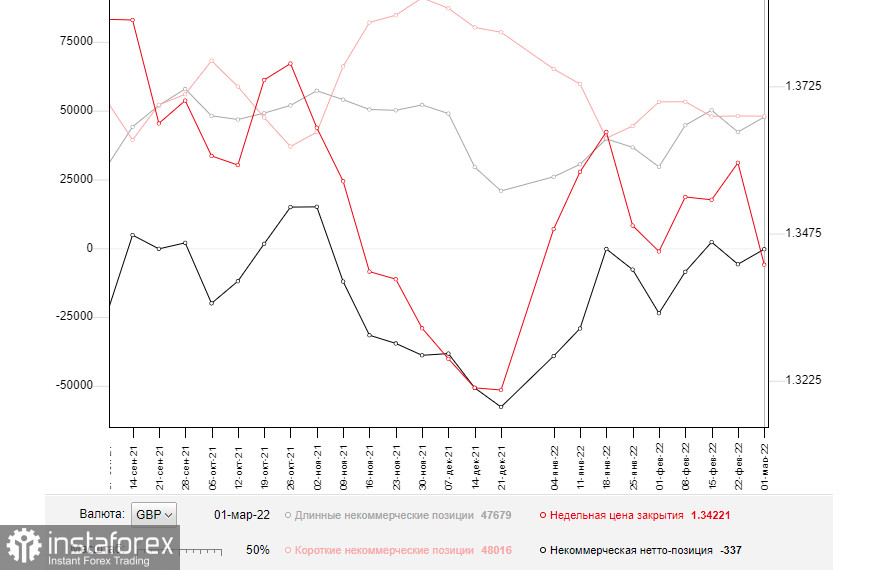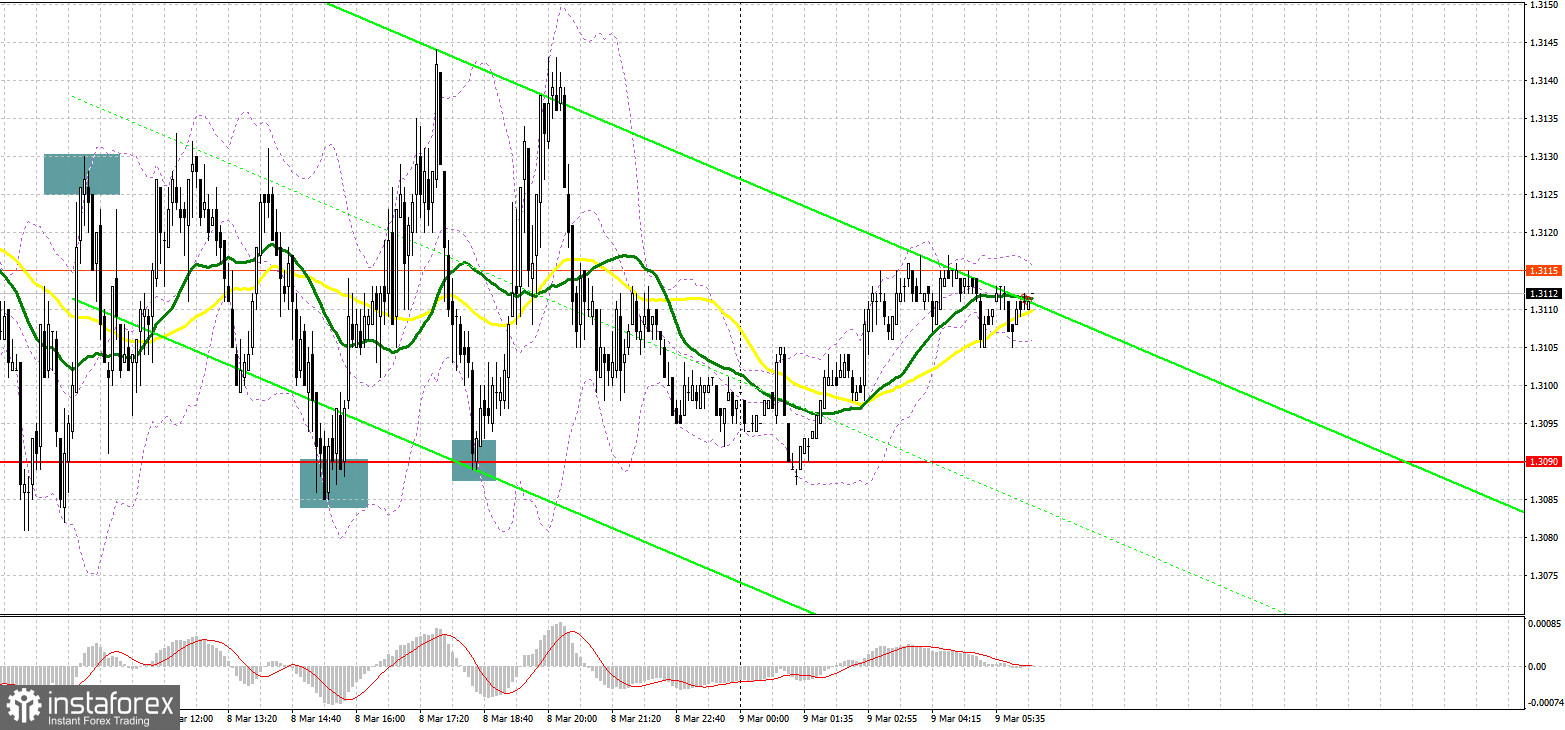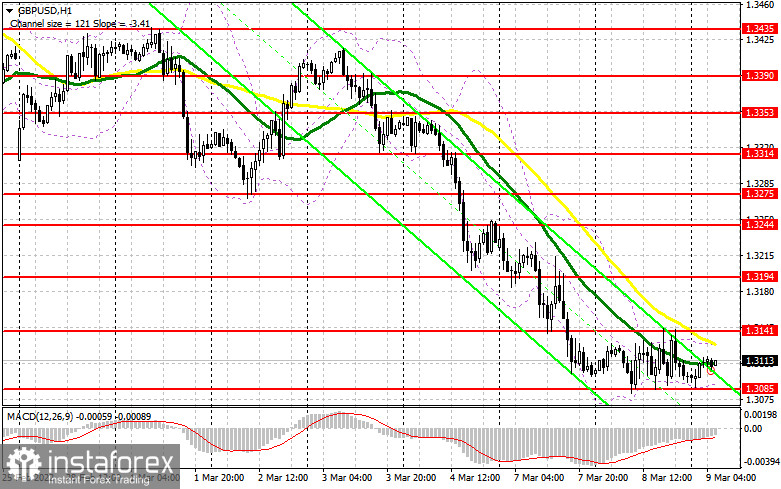When to open long positions on GBP/USD:
Three strong entry signals were produced yesterday. Let's look at the M5 chart and analyze them. In my previous analysis, I paid attention to the 1.3128 level and said you could consider entering the market from it. Bears failed to consolidate below the weekly low, and the pound recovered to the 1.3128 resistance level. A sell signal was made after the formation of a false breakout and the failed attempt of bulls to go above the mark. Consequently, the pair fell by 25 pips. In the second half of the day, the pound returned to the 1.3090 support level, a few false breakouts occurred, and a buy signal was produced. So, the pair went up by 50 pips.

Before proceeding with the technical analysis of the pound, let's take a look at Commitments of Traders for March 1. The report logged a sharp rise in long positions and a fall in short ones. The negative delta increased almost to the zero level. However, it is important to understand that such reports are now of secondary importance. The situation in the market changes almost every day. The market experiences fluctuations of 100-200 pips due to the ongoing geopolitical conflict. The report is highly likely to reveal a significant increase in short positions next week. Therefore, you should pay less attention to the current results. Neither the Bank of England's nor the Federal Reserve's stance on monetary policy will matter if the armed conflict gets more tense. Russia and Ukraine have agreed to hold peace talks. A lot will depend on the outcome of these meetings. At the same time, it is clear that high inflation in the UK will urge the BoE to adopt a more aggressive stance on monetary policy. Due to a slowdown in economic growth and retaliatory sanctions from Russia, the regulator is unlikely to go for a sharper increase in interest rates, which should be done because consumer incomes will plummet otherwise. The COT report for March 1 revealed a rise in long non-commercial positions to 47,679 versus 42,249 and a drop in short non-commercial positions to 48,016 from 48,058. The total weekly non-commercial net position increased to -333 versus -5,809. The weekly closing price fell to 1.3422 from 1.3592.

The pair is likely to move in the sideways channel due to the lack of fundamentals today. Just a few traders are willing to buy GBP/USD at the current lows. A lot will depend on how the military conflict unfolds in Ukraine and whether there is any breakthrough in the peace talks between the parties. Today, bulls will try to protect the 1.3085 support level where bullish moving averages are now located. This is a key level because if the pound returns below it, pressure on the pair will increase. If the quote goes down, a false breakout at 1.3085 and hawkish statements by the BoE will produce a signal to purchase GBP/USD with the target at the 1.3141 resistance level. Yesterday, the pair failed to break above it. A breakout and a test of this mark from top to bottom will make an additional entry point. If so, the instrument will rise to the high of 1.3194, with the target at the 1.3244 resistance level. The 1.3275 mark will serve as a farther target where you should consider taking a profit. However, the pair will be able to go there if geopolitical tensions ease. In the event of a fall during the European session and a decrease in bullis activity at 1.3085, you could go long when the price reaches 1.3034 or approaches the 1.2976 support level. The bearish trend will continue if a false breakout is formed at these levels. If so, an entry point will be made and the price then may rebound in the short term. Long positions on GBP/USD could be entered immediately on a rebound from 1.2914, allowing a 20-25 pips correction intraday.
When to open short positions on GBP/USD:
The US inflation report scheduled for tomorrow may trigger market jitters. So far, bears feel relatively calm. In the event of escalating geopolitical tensions, bearish activity will increase. Otherwise, they will rapidly exit the market. If so, the pound will strengthen. The pair traded in the region of the moving averages, indicating a balanced market, which is usually the case ahead of important macro reports. Bears will try to protect the bearish pivot point of 1.3141, which is also the upper limit of the narrow sideways range formed last week after a plunge in the pound. A false breakout at 1.3141 will form a sell entry point. If so, the pair will go down to 1.3085. This level is bulls' last hope for an upward correction. A breakout and a retest at 1.3085 from bottom to top will trigger a row of stop orders, and GBP/USD will plummet to the 1.3034 and 1.2976 lows. The 1.2914 mark will serve as a farther target where you should consider taking a profit. In the event of a rise during the European session and a decrease in bearish activity at 1.3141, it would be wise to go short as soon as the price reaches the 1.3194 resistance level and only if there is a false breakout. Short positions on GBP/USD could be entered immediately on a bounce from the 1.3244 high or 1.3275, allowing a 20-25 pips correction intraday.

Indicator signals:
Moving averages
Trading is carried out in the range between the 30-day and 50-day moving averages, indicating market uncertainty.
Note: The period and prices of moving averages are viewed by the author on the hourly chart and differ from the general definition of classic daily moving averages on the daily chart.
Bollinger Bands
Pressure on the pair will increase in case of a breakout of the lower band at 1.3085. Meanwhile, a breakout of the upper band at 1.3130 will lead to a new wave of growth in the pound.
Indicator description:
- Moving average (MA) determines the current trend by smoothing volatility and noise. Period 50. Colored yellow on the chart.
- Moving average (MA) determines the current trend by smoothing volatility and noise. Period 30. Colored green on the chart.
- Moving Average Convergence/Divergence (MACD). Fast EMA 12. Slow EMA 26. SMA 9.
- Bollinger Bands. Period 20
- Non-commercial traders are speculators such as individual traders, hedge funds, and large institutions who use the futures market for speculative purposes and meet certain requirements.
- Long non-commercial positions are the total long position of non-commercial traders.
- Non-commercial short positions are the total short position of non-commercial traders.
- Total non-commercial net position is the difference between short and long positions of non-commercial traders.





















